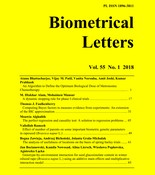
Biometrical Letters Vol. 55(1), 2018, pp. 85-96


The objective of this study was to assess genotype-by-environment interaction for seed glucosinolate content in winter rapeseed cultivars grown in western Poland using the additive main effects and multiplicative interaction model. The study concerned 25 winter rapeseed genotypes (15 F1 CMS ogura hybrids, parental lines and two European cultivars: open pollinated Californium and F1 hybrid Hercules), evaluated at five locations in a randomized complete block design with four replicates. The seed glucosinolate content of the tested genotypes ranged from 5.53 to 16.80 µmol•g-1 of seeds, with an average of 10.26 µmol•g-1. In the AMMI analyses, 48.67% of the seed glucosinolate content variation was explained by environment, 13.07% by differences between genotypes, and 17.56% by genotype-by-environment interaction. The hybrid PN66×PN07 is recommended for further inclusion in the breeding program due to its low average seed glucosinolate content; the restorer line PN18, CMS ogura line PN66 and hybrids PN66×PN18 and PN66×PN21 are recommended because of their stability and low seed glucosinolate content.

Brassica napus; seed glucosinolate content; AMMI; stability

